Airedale Terrier
The largest of terrier breeds and they are often called " king of terriers."
PHYSICAL CHARACTERISTICS:
Size: Male- 58-61 cm (23-24 ins), Female 56-58 cm (22-23 ins)
Weight: Male 18-23 kg (40-50 lb) Female 18-20 kg (40-45 lb)
COAT TYPE - The Airedale's coat is wiry, dense, and water proof. It requires a great deal of grooming, he sheds twice a year and at such times it is good for him to be trimmed or stripped by a professional, most owners trim them 3 -4 times a year.
COAT COLOR - Tan with black markings on the sides and upper parts of the body. Making him look like he's wearing a black saddle.
TEMPERAMENT - The Airedale is intelligent, reliable and loyal. Although they need a firm hand to overcome their stubbornness. The Airedale makes a good watchdog; they consider that his owner's property is his to look after. His loud voice can be very convincing to any intruder. The Airedale is good natured and fun loving, they have and excellent reputation as a family dog and are great with children, but should always be supervised during play.
CARE - The Airedale's hard shorthaired, double coat is easy to groom and sheds very little. Although regular brushing is necessary, they need plenty of exercise, and are bored easily which leads to their true love digging large holes in the yard! Airedale's may suffer from hip
dysphasia, eye and skin problems. Extra oil added to their diet may help with dry, itchy skin. He is a well-built dog and naturally needs an adequate supply of nutrition.
TALENTS - The Airedale was bred to hunt otter, badgers, and wolves. It has since been used in police and military work.
IS THIS DOG FOR YOU? - The Airedale is a lively, water-loving dog, and adapts and fits in well with family life. They are incorrigible diggers and are easily bored, so they need to be kept occupied! They love wide-open spaces to romp and play. Their coat needs a great deal of grooming and may need professional help to maintain properly. They are not difficult to train, and respond better to praise than punishment. The Airedale is a wonderful loving companion for those who have the time to spend with them and energy to exercise them. It is recommended that you have a sense of humor or you shouldn't have an Airedale. These freethinking animals are clownish with loads of personality. They are an athletic breed with energy, drive, stamina, and are not yappy like some of the smaller terriers.
Yorkshire Terrier
Developed about a century ago to catch rats. It is a blend of various terriers: English, Scottish and Maltese. The Yorkie seen today is much smaller than their forebears.
TEMPERAMENT - Yorkies are alert, brave, feisty and loyal. They are tough, ready to play with the children or remove any rat or mouse
unwise enough to be in the house.
PHYSICAL CHARACTERISTICS:
Size: Male- 18-23 cm (7-9 ins) Female- 18-23 cm (7-9 ins)
Weight: Male- 2-3 kg (4-7 lb) Female- 1.5-3 kg (3-7 lb)
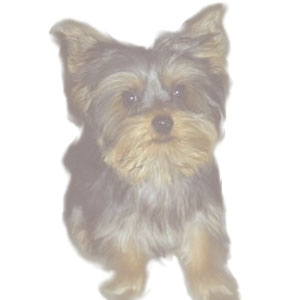 COAT TYPE - Hair is glossy, fine and silky in texture. Coat on the body is moderately long and perfectly straight (not wavy). It may be trimmed to floor length to give ease of movement and a neater appearance, if desired.
COAT TYPE - Hair is glossy, fine and silky in texture. Coat on the body is moderately long and perfectly straight (not wavy). It may be trimmed to floor length to give ease of movement and a neater appearance, if desired.
COAT COLOR - The coat is steel-blue on the body and tail, and tan elsewhere. Puppies are born black and tan and are normally darker in body color.
CARE -Grooming represents quite a commitment in time and effort. Daily combing and brushing and regular shampooing are necessary to keep the lustrous hair in top condition. It is important to keep the hair out of the dog's eyes. If your Yorkie is not for show, it can be clipped short for easy care. They are ideal for apartment living, although it doesn't need a lot of exercise, this lively little dog will benefit from regular opportunities to run and play. May be subject to eye problems, as well as deterioration and dislocation of hip and knee joints.
IS THIS DOG FOR YOU? -Easy going lively little dog, great for the family. Makes a great companion. Despite its small size, it makes an excellent watchdog, defending its territory in no uncertain manner.
Labrador Retriever
PHYSICAL CHARACTERISTICS:
Size: Male- 56-61 cm (22-24 ins) Female- 53-58 cm (21-23 ins)
Weight: Male- 27-34 kg (60-75 lb.) Female- 25-32 kg (55-70 lb.)
COAT TYPE - short hair, smooth, double coat (soft under layer with long guard hair on top), water proof, and easy to groom.
COAT COLOR - black, yellow, or chocolate.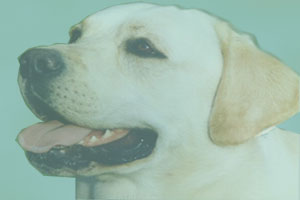
TEMPERAMENT - loyal, reliable, obedient, very friendly, excellent with children, easily trained, willing, high-spirited, love to play, love attention, eager to please, they are non-aggressive so they make a great watch dog not a guard dog!
CARE - are generally low maintenance, are moderate shedders so daily grooming isn't necessary, brush weekly with a firm bristle brush. they are big eaters and have a tendency to overeat and therefore become overweight, so lots of exercise is needed.
TALENTS - hunting, tracking, retrieving watch dogging, police work, narcotics detection, guide dog for blind, service dog for disabled, search and rescue, sledding, carting, agility and competitive obedience.
LIFE EXPECTANCY - 10-12 years labs make wonderful family pets, great hunting dogs, and are good show dogs as well.
German Shepherd
PHYSICAL CHARACTERISTICS:
Size: Male 61-66 cm (24-26 ins) Female 56-61 cm (22-24 ins)
Weight: Male 34-43 kg (75-95 lb) Female 32-41 kg (70-90 lb)
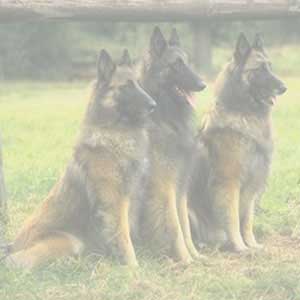 COAT TYPE - their coat has a variety of lengths from short to long coats. They have a double-coat, with a coarse, water resistant outer coat and a heavy woolly undercoat. They are heavy shedders and require regular combing.
COAT TYPE - their coat has a variety of lengths from short to long coats. They have a double-coat, with a coarse, water resistant outer coat and a heavy woolly undercoat. They are heavy shedders and require regular combing.
COAT COLOR - the coat most often comes in black with tan and fawn markings, but other colors do occur. Black and red, black and cream, black and silver, solid black, sable and white. White is considered a fault in the u.s. and can't enter breed classes at shows.
TEMPERAMENT - German Shepherds are loyal, courageous, confident and highly trainable, they are strong, agile, alert and full of life. They have uncanny intelligence and faithfulness . They should not be timid, nervous, vicious or gun-shy. Once a German Shepherd has bonded to his owner he will bond for life.
CARE - German Shepherds need daily grooming as they are heavy shedders especially in spring. Bathe or dry shampoo only when necessary. They require strenuous activity preferably combined with training . They have a tendency to bloat so its best to give them 2 or 3 small portions instead of one large meal. Shepherds are susceptible to many genetic problems, including hip and elbow
dysphasia, skin ailments, bloat, genetic eye diseases, epilepsy and heart defects.
TALENTS - German Shepherds are ready and willing to do just about any job. They make faithful family companions, guide dogs, police dogs, they are used for search and rescue, drug detection and handicapped helpers and anything else you can train them to do! They love to please.
IS THIS DOG FOR YOU? - German Shepherds are very sociable dogs, they need attention and companionship. They do not do well tied or left in isolation, it causes frustration and boredom, making for a potentially dangerous dog. They require lots of exercise especially while growing. German shepherds are strong in body, spirit and mind. They need much attention, love and discipline as they grow. ( which they do quite quickly).
The Pug
PHYSICAL CHARACTERISTICS:
Size: Male- 30-36 cm (12-14 ins) Female- 25-30 cm (10-12 ins)
Weight: Male- 6-9 kg (13-20 lb) Female- 6-8 kg (13-18 lb)
COAT TYPE - The pugs coat is fine, smooth soft, short and glossy. Pugs shed!
COAT COLOR - The soft coat comes in silver, apricot, fawn, and black, all with black muzzle and velvety ears.
TEMPERAMENT - The pug is a dog who tends to make people smile when they see him, because he is so convinced of his own importance. The pug is an even - tempered breed, which exhibits stability, playfulness, great charm, dignity and an outgoing loving disposition. The pug is adaptable, sociable and good-natured and makes a good family dog. Pugs combine a cocky confidence with a friendly, sensitive nature. they are great with kids and thoroughly relish playtime and exercise. The pug has been referred to as " multo in parvo " meaning " a lot of dog in a small space ".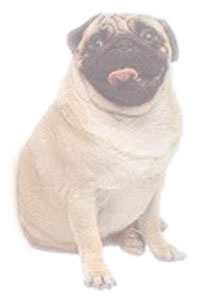
CARE - Pugs shed. They are very sensitive to heat, humidity and cold, so they cannot be kept as an outside dog. Pugs can die quickly when exposed to extreme heat or cold. They cannot be left outside for extended periods of time unattended. Pugs need regular cleaning of their nose wrinkles and ears. Their nails need to be kept short to minimize scratching their eyes. Pugs like short walks, they cannot tolerate hard exercise and they have no stamina. Pugs cannot swim, they are very solid and tend to sink instead of float! They are prone to allergies and chronic breathing problems.
TALENTS - Pugs make a tolerable watchdog - will alert to the presence of strangers, good family companions, therapy dogs, hearing aid dogs. Pugs were originally bred for lap dogs.
IS THIS DOG FOR YOU? - Pugs require a lot of time and attention. If you do not want a dog that wants to be with you all the time, don't get a pug. If left alone for many hours a day pugs may have behavioral problems and possible depression. Pugs are inside dogs, they can't be left outside unattended. Pugs shed and love sitting on furniture! Because of their short noses, pugs snort, sneeze, and snore. make sure you are willing to make a lifetime commitment to the dog you bring home. Pugs can live up to 17 or 18 years.
Dalmatian
PHYSICAL CHARACTERISTICS:
Size: Male- 56-63 cm (22-25 ins) Female- 53-61 cm (21-24 ins)
Weight: Male- 23-29 kg (50-65 lb) Female- 20-27 kg (45-60 lb)
COAT TYPE - Smooth, lustrous, shorthaired, hard, dense coat. Easy to groom
COAT COLOR - The base color is pure white with either black or liver-colored spots randomly splashed over it. Puppies have no spots, the marks develop during the first year of life.
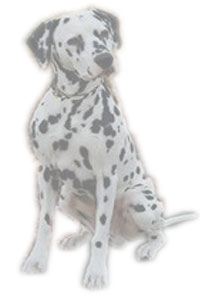 TEMPERAMENT - The Dalmatian is the original "spotted dog" . They are playful and spirited, these dogs adore children. They are wary enough to be a watch dog and become very attached to their owners. Training takes patience and gentle but firm and consistent handling, as they are rather sensitive. Dalmatian's are outgoing and friendly.
TEMPERAMENT - The Dalmatian is the original "spotted dog" . They are playful and spirited, these dogs adore children. They are wary enough to be a watch dog and become very attached to their owners. Training takes patience and gentle but firm and consistent handling, as they are rather sensitive. Dalmatian's are outgoing and friendly.
CARE - The Dalmatian is an easy care dog. It's only need is to be exercised regularly and vigorously or it may become bored and destructive. It needs no special feeding requirements, and its coat is easy to care for, and sheds very little. Problems to be aware of are skin allergies and urinary bladder stones, also prone to deafness.
TALENTS - Its main job was to run beside carriages in nineteenth-century Europe, either to protect the travelers inside or for appearance. It also kept the stables clear of rats. He was also used to control the horses that pulled fire carriages and is still a well-known fire house mascot. The Dalmatian has been also used as a bird dog and a retriever
IS THIS DOG FOR YOU? - Makes a great family dog, is at times very guarded with strangers. Needs plenty of exercise, which makes it not an ideal dog for the apartment dwellers, unless you are ready to give it plenty of exercise several times a day. They need no special feeding requirements, and the coat is easy to groom, with minimal shedding. These dogs live to a ripe old age and never seem to slow down
Bloodhound
The testimony of a Bloodhound's man trailing results is acceptable in almost any court! The Bloodhound has a history as the number one tracker of the canine world. His long ears are said to sweep scent from the trail up into his large nostrils.
PHYSICAL CHARACTERISTICS:
Standard Size: Male- 63-69 cm (25-27 ins) Female- 58-63 cm (23-25 ins)
Weight: Male- 40-50 kg (90-110 lb) Female- 36-45 kg (80-100 lb)
COAT TYPE - A Bloodhounds skin is thin to the touch and extremely loose, this being more noticeable about the head and neck where it hangs in deep folds. The coat is smooth, shorthaired and easy to groom.
COAT COLOR - Bloodhounds are black and tan, liver and tan and red. The darker colors being interspersed with lighter or badger-colored hair, sometimes flecked with white. May have a small amount of white on the chest, feet and the tip of the tail.
TEMPERAMENT - Bloodhounds are extremely affectionate, sensitive and gentle, they become devoted to their master and get along well with people and other dogs. They are shy and sensitive to kindness or correction by their master. The bloodhound is rarely vicious, but is too shy to be a very good watchdog.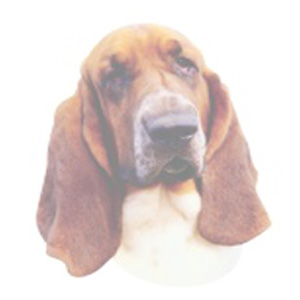
CARE - These large dogs need regular, vigorous exercise, but if he picks up an interesting scent you may have difficulty in getting his attention. Brush with a firm bristle brush, and bathe only when necessary. A rub with a rough towel or chamois will leave the coat gleaming. Clean the long floppy ears and eyes daily with a damp cloth. A padded bed is welcome to avoid calluses on the joints. Bloodhounds eat massive amounts and greedily, the general advice is to feed small quantities several times a day and not to take a Bloodhound out for exercise on a full stomach, as they are prone to bloat.
TALENTS - The Bloodhound has entered legend and literature as the archetypal sleuth dog with the mournful howl, but it never kills its prey. It is able to follow any scent, even a human's which is a rare ability among dogs. Once on a collar and lead he may choose to take his handler on without any regard to physical or vocal opposition!
IS THIS DOG FOR YOU? - Bloodhound's are very large dogs, that little puppy grows at a rapid rate, about 4 - 5 pounds a week. Males can grow up to 135 lb.. They do not live long, up to 10 years, some longer and some not as long. They need a lot of food and exercise. You will require a fenced yard as they have a one track mind when smelling something they want to follow. Nothing will stop them once they've set their mind to it. Bloodhound's drool and slobber, you will need wipe cloths throughout your home to clean up and wipe up. Bloodhound's are great with small children, but they may unknowingly knock the little child down because of their large size and should not be left alone with small children. Properly handled by those who are prepared to understand them, they are a fascinating breed to live with.
Old English Sheepdog
Commonly called the Bobtail. The breed goes back 150 years or more. They were developed for herding livestock both sheep and cattle.
TEMPERAMENT - Playful, cheerful, friendly, outgoing and intelligent. They learn quickly, but need firm and consistent training. They are capable of making good watchdogs, with a highly distinctive bark.
PHYSICAL CHARACTERISTICS:
Size: Male- 56-61 cm (22-24 ins) Female- 20-56 cm (20-22 ins)
Weight: Male- from 29 kg (65 lb) Female- from 27 kg (60 lb)
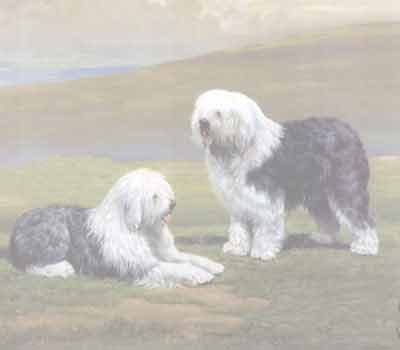 COAT TYPE -It's coarse and longhaired coat with a dense, waterproof undercoat. Outer hair can be up to 2 feet long and shaggy not curly.
COAT TYPE -It's coarse and longhaired coat with a dense, waterproof undercoat. Outer hair can be up to 2 feet long and shaggy not curly.
COAT COLOR - Grey,grizzle, blue or blur merle, with or without whit markings
CARE - Old English Sheepdogs were developed for hard work and love regular vigorous exercise. They adapt well to urban living but need plenty of space to run. These dogs need extensive grooming. Unless they are combed and brushed through to the dense undercoat at least 3 times a week, they can become matted and may develop skin problems or be plagued by parasites. (In earlier times these dogs were shorn along with the sheep) Clip out any mats or tangles carefully with a blunt scissors. Taken to a professional groomer every couple of months or so will keep things under control. No special feeding requirements. These dogs can be subject to hip
dysphasia, also susceptible to genetic eye diseases. They are not suited to hot climates.
IS THIS DOG FOR YOU? - Old English Dogs make great family pets, if you are
committed to the dog's exercise and can cope with its grooming demands. They are loyal and join in every possible activity with enthusiasm,
Border Collie
PHYSICAL CHARACTERISTICS:
Size: Male- 46-53 cm (18-21 ins) Female- 43-51 cm (17-20 ins)
Weight: Male 14-20 Kg (30-45 lb) Female- 12-19 Kg (27-42 lb)
COAT TYPE - The border collie has two varieties of coats, both having soft, dense weather resistant double coat. The rough coat is medium to long, texture from flat to slightly wavy. Short and smooth coat on their face, forelegs are feathered. The smooth coat is short over the entire body. May have feathering on forelegs and fuller coat on chest.
COAT COLOR - Border collies come in a variety of colors; having various combination of patterns and markings. Solid color, bicolor, tricolor, merle and sable dogs, as well as the traditional markings of black with or without the white blaze, collar, stockings and tail tip, with or without tan points.
TEMPERAMENT - Border collies have intense concentration, deep desire to please, as well as speed and intelligence. This gives the breed the edge in just about any job they undertake. They are easily obedience trained, but harsh training can make them submissive. Border collies thrive on hard work and play
CARE - Border collies do shed! And require regular brushing. They demand vigorous regular exercise, not just for their muscles but for their mind as well. They require no special food, but don't allow them to become obese and lazy. These dogs are generally hardy, but can be subject to some joint and genetic eye problems.
TALENTS - Border collies number one love is working stock, second to this they are well suited to most canine sports- obedience, tracking and the fast growing sport of agility
IS THIS DOG FOR YOU? - The supreme sheep herding dog, the border collie lives to work. This is the dog for the athletic person who is ready to engage a dog in directed activities. As pets border collies have a mixed record. While some people have no difficulty controlling the dogs' herding instinct, high energy and quick minds. Less skilled owners may be frustrated by these traits. The calm, well-behaved dogs seen at sheep dog trials are the result of careful attention to the dogs mental and physical needs. Border collies that herd are fulfilled. In pet environments, with experienced dog people who give them the structure, love and fellowship they crave, they can be superb pets. With less skilled owners, unfortunately they can become a neurotic nuisance. Before you acquire a border collie puppy be sure you want to spend 2 years training and 13 more enjoying a highly energetic dog. Be honest with yourself are you able to give this dog the life it needs?
Scottish Terrier
Bred in Scotland to hunt foxes and badgers.
PHYSICAL CHARACTERISTICS:
Size: Male- 25-28 cm (10-11 ins) Female- 23-25 cm (9-10 ins)
Weight: Male- 9-10 kg (19-23 lb) Female- 8-10 kg (18-22 lb)
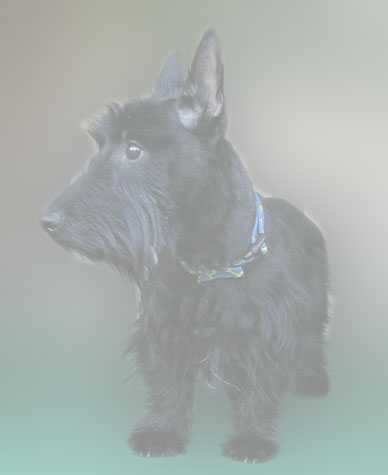 COAT COLOR - Black, Wheaten or Brindle of any color.
COAT COLOR - Black, Wheaten or Brindle of any color.
COAT TYPE - Harsh, wiry, weather resistant outer coat, with a soft dense under coat.
TEMPERAMENT - Scotties are loving, gentle, loyal, dependable, may appear aloof and independent. They can be stubborn and need firm handling from an early age or will dominate the entire household. They are very sensitive and will make a good pet to someone who understands their nature. The Scottish Terrier tends to bark allot and would make a good watchdog, they also can be scrappy with other dogs.
CARE - This breed sheds little or no hair. Two to three brushings a week is needed to keep his coat tidy, and should be trimmed twice a year. The Scottish Terrier doesn't need a lot of exercise and can be kept indoors with a few daily walks. They are ideal for apartment living. But a fenced yard will keep him fit. They love to fetch sticks or balls. No special feeding requirements, but be careful of over feeding or they will become obese and lazy. The Scottish Terrier is generally sturdy and robust, but prone to skin aliments, including sensitivity to fleas, which may cause chronic skin problems.
Training must be firm but gentle to avoid breaking his spirit, a Scottie will be insulted buy severe treatment.
IS THIS DOG FOR YOU? - Great companion for apartment living, but beware they tend to bark allot, and make a fierce sounding watchdog.. If you have a fenced in yard, keep close watch on him as he will dig himself out if he wants to! The Scottish Terrier lives about 12- 15 years, so you'll have many happy years with this dog. You will have a gentle, loyal, loving dog but beware they may become aggressive towards other dogs. They are very sensitive and need firm gentle training, and will make a good pet for anyone who understands their nature.
The Irish Wolfhound
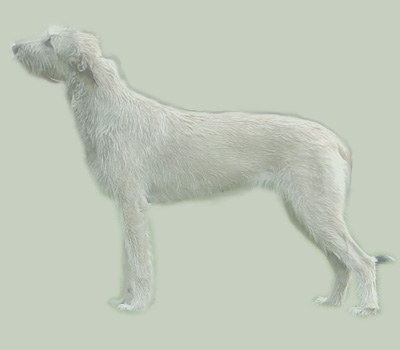 The beginnings of Irish Wolfhounds can be traced back as early as 273 B.C. through ancient woodcuts and writings. Ownership of these great hounds were
emperors, kings, nobility and poets; their chains and collars were often of precious metals and stones. They were held in such high esteem that when disputes arose over them, not only individual combats but full scale wars often occurred. By the year 391 A.D., the breed was known in Rome, when the first authentic mention of it was written by the Roman Consul Quintus Aurelius, who had received seven of them as a gift which "all Rome viewed with wonder." The beginnings of Irish Wolfhounds can be traced back as early as 273 B.C. through ancient woodcuts and writings. Ownership of these great hounds were
emperors, kings, nobility and poets; their chains and collars were often of precious metals and stones. They were held in such high esteem that when disputes arose over them, not only individual combats but full scale wars often occurred. By the year 391 A.D., the breed was known in Rome, when the first authentic mention of it was written by the Roman Consul Quintus Aurelius, who had received seven of them as a gift which "all Rome viewed with wonder."
The Howling Dog
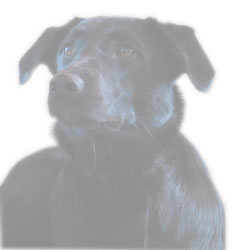 A universally believed fact about dogs is that they have the ability of second sight. It is said that a dog can see apparitions and sense if death is imminent. This may be because that dogs can sense chemical changes in the air, and it is known that the human body undergoes such changes before death. Evidence shows that dogs howl when their owner is ill. Thus to hear a dog howling has long been considered to be a death omen and especially if it howls by an open door. The final hours of death was thought to be marked by a dog howling three times. Again, to some it may be a "pet" superstition. A universally believed fact about dogs is that they have the ability of second sight. It is said that a dog can see apparitions and sense if death is imminent. This may be because that dogs can sense chemical changes in the air, and it is known that the human body undergoes such changes before death. Evidence shows that dogs howl when their owner is ill. Thus to hear a dog howling has long been considered to be a death omen and especially if it howls by an open door. The final hours of death was thought to be marked by a dog howling three times. Again, to some it may be a "pet" superstition.
Reindeer Dog of Norway
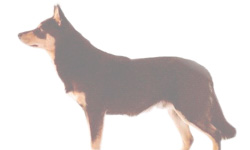 Once, several dogs sitting on a hill-top saw a few people desperately trying to gather up a herd of reindeer. Having looked at the idle yelling and running around for a while, the dogs decided: "We could do that better". Thus the reindeer herdsmen got a willing helper! After all, dogs are man's best friend. Once, several dogs sitting on a hill-top saw a few people desperately trying to gather up a herd of reindeer. Having looked at the idle yelling and running around for a while, the dogs decided: "We could do that better". Thus the reindeer herdsmen got a willing helper! After all, dogs are man's best friend.
|
|

